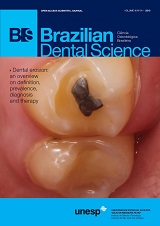A comparison of methods used to determine chewing side preference in deciduous, mixed and permanent dentitions
DOI:
https://doi.org/10.14295/bds.2013.v16i1.870Resumen
Objective: The purpose of this study was to determine whether ‘chewing side preference’ (CSP) is correlated to ‘chewing side preference during the first chewing cycle’ (CSP1ºC) in the deciduous, mixed and permanent dentitions.Methods: Three-hundred subjects were divided in 3 groups: Group 1 – 100 children 3-5 years old, primary dentition; Group 2 – 100 children 6-12 years old, mixed dentition; Group 3 – 100 subjects 18-47 years old, permanent dentition. CSP was determined using a method developed by McDonnell et al. (2004). Subjects were given a piece of gum and the position of the chewing gum was recorded 7 times as right or left. Subjects were classified as ‘observed preferred chewing side’ (OPCS) when they performed 5/7, 6/7 or 7/7 strokes on the same side. OPCS corresponded to the CSP. CSP1ºC was determined using a method developed by Hoogmartens and Caubergh (1987). Subjects were given five pieces of gum and the position of the chewing gum at first chewing cycle was recorded as right or left. For each subject, an index (I) was performed. The Chi-square (X2) and phi correlation (r) tests were used to investigate signi?cant correlations between CSP and CSP1ºC. Results: There was a strong positive and significant correlation between CSP and CSP1ºC for primary dentition (p=0.000; r=0.82), for mixed dentition (p=0.000; r=0.81) and a very strong positive and significant correlation for permanent dentition (p=0.000; r=0.90). Conclusion: CSP can be significantly correlated to CSP1ºC for primary dentition, mixed dentition and permanent dentition, and these are strong positive relationships for primary and mixed dentitions and very strong positive relationship for permanent dentition.
Descargas
Descargas
Publicado
Cómo citar
Número
Sección
Licencia
Brazilian Dental Science uses the Creative Commons (CC-BY 4.0) license, thus preserving the integrity of articles in an open access environment. The journal allows the author to retain publishing rights without restrictions.
=================
COPYRIGHT TRANSFER AND RESPONSIBILITY STATEMENT
(PDF)
For all articles published in the BDS journal, copyright is retained by the authors. Articles are licensed under an open-access Creative Commons CC BY 4.0 license, meaning that anyone may download and read the paper for free. In addition, the article may be reused and quoted, provided that the original published version is cited. These conditions allow for maximum use and exposure of the work while ensuring that the authors receive proper credit. All metadata associated with published articles is released under the Creative Commons CC0 Universal Public Domain Dedication.
Before the submission, authors must obtain permission to reproduce any published material (figures, schemes, tables, or any extract of a text) that does not fall into the public domain or for which they do not hold the copyright. Permission should be requested by the authors from the copyright holder (usually the Publisher, please refer to the imprint of the individual publications to identify the copyright holder).
The authors hereby attest that the study is original and does not present manipulated data, fraud, or plagiarism. All names listed made a significant scientific contribution to the study, are aware of the presented data, and agree with the final version of the manuscript. They assume complete responsibility for the ethical aspects of the study.
This text must be printed and signed by all authors. The scanned version should be submitted as supplemental file during the submission process.
























